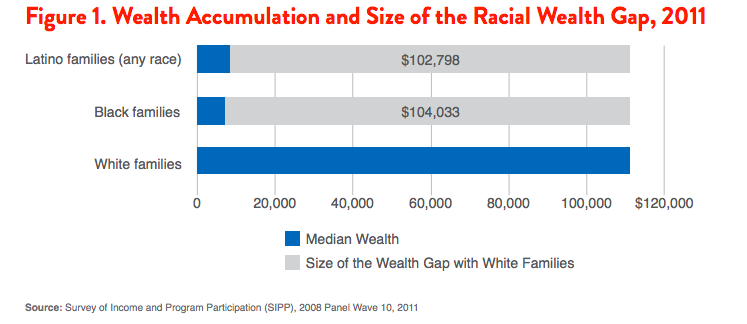I once wrote an article on how affirmative action doesn’t actually disadvantage White people – despite how many of us believe the opposite.
And a few members of my family weren’t happy about that article. Quite sure that affirmative action for people of Color is “reverse racism,” they gave me an earful.
In their reaction lies the tremendous irony that hangs over most White opposition to programs designed to help people of Color access the schools and jobs from which they’ve been historically excluded.
After all, while affirmative action programs, which have been shown to help White women more than anyone, are a recent creation, there have been systems and structures designed to benefit White people at the expense of everyone else for hundreds of years.
In fact, that which we often call the “American Dream” is built fundamentally upon violent affirmative action programs for White people.
And I’m not just talking about the overt (though coded) forms of affirmative action that we White folks benefit from today.
The entire history of European settlement in North America is a story of unearned benefit that comes at the expense of people of Color.
This notably sets it apart from formal affirmative action programs for people of Color, such as those in admissions to universities, as they haven’t been proven to systemically disadvantage White people in any way.
To understand the White “American Dream,” though, we need to understand the history of Whiteness and its ever-changing and evolving nature.
As highlighted by scholars like Dr. Jacqueline Battalora and Dr. Nell Irvin Painter, Whiteness didn’t always exist.
In fact, prior to the 1690s, “White” people were unheard of.
Wealthy, land-owning Europeans created the category of Whiteness as a tool to divide poor, light-skinned Europeans from enslaved African people and Indigenous people in North America.
Since that time, it has taken on a life of its own and been embedded in every single structure of the US.
This club, known as Whiteness, was designed to offer advantages, some small and some large, to light-skinned Europeans in exchange for their complicity in the theft of Indigenous land and the enslavement and exploitation of non-White people.
Notably, not all light-skinned Europeans were initially considered White (Italians and the Irish didn’t join the club until well into the 20th century, and European Jews have only recently been able to join).
Whiteness has evolved over time, but its singular aim has been to ensure that certain people (wealthy, White men mostly) hold power built upon the exploitation of people of Color and, to a lesser degree, poor White people.
It’s important, then, that we as White people understand this identity creation story because in this history lies an understanding of the privileges so many of us call the “American Dream” – something disproportionately available to people considered White.
Does this mean that people of Color haven’t realized this “Dream?” No. It just means that this “Dream” has been a nightmare for most people of Color built upon genocide, exclusion, and slavery.
1. White Wealth Is Tied to Land – So White Wealth Is Bound Up in Genocide
Let’s face it – land is the cornerstone of the “American Dream.”
The most recent economic downturn aside, “buy a home” or “invest in land” has historically been sound economic wisdom for attaining financial stability.
But I doubt many of us consider when buying a home that our land purchase is a fundamentally political act.
After all, every acre of land in North America owned by White people is occupied Indigenous land, and White people have been given unbridled access to this land while people of Color, including the original inhabitants of the land, have been systematically denied that access.
Despite what we learned in school, the European “acquiring” of land has been brutally genocidal from the moment Columbus arrived in what we now call the Americas.
From forced relocation to scalp bounties to intentional biological warfare to mass hangings, my ability to buy a house exists because of land theft, and as such, the wealth of the White American middle class is literally built on genocide.
White people have been given unparalleled access to this land through intentional government handouts.
The Land Grant Acts, the Homesteading Act, redlining policies, and the GI bill, among a myriad of other state policies, all gave away land for little or no cost to White settlers while explicitly or implicitly barring non-White people from acquiring property.
And housing and land discrimination continues to this day!
So though I don’t think it’s what Obama meant when he said, “You didn’t build that,” he’s actually right – we may have worked incredibly hard and struggled for what we have, but White access to land (and by extension wealth) has been a form of affirmative action for White people since Whiteness was first created.
2. All White People Benefit from the Institution of Slavery (Yes, Even If Your Family Didn’t Own Slaves)
I once had someone try to tell me that slavery had little to do with the United States being the wealthiest country in the world.
His argument was that American (mostly White) ingenuity and freedom had created the wealthiest nation in the history of the world.
I thought he was an ignorant jerk.
And then I realized that tons of people believe this – as if hundreds of years of unpaid labor from millions of enslaved people didn’t lay the foundation for the economy in which we live today!
Pair this unpaid labor with White access to land and the coincidental explosion in technological advancement (sure, chock that up to ingenuity), and we have the foundation for this:

(Source. Really, though, read the article.)
The system of slavery was designed to offer economic opportunity to White people while denying those same opportunities to and exploiting the labor of people of Color.
For some White folks, the opportunity was far less profitable (such as working as an overseer or in a factory processing the spoils of slave labor), while for others it afforded land ownership. But it benefitted all White folks.
In short, those with power decided it was better to provide even the paltriest of opportunities to poor Europeans/White people rather than risk a unification of poor people that would result in revolution.
And while we pretend that slavery ended with the Civil War, the truth is that slavery persists to this day through the “New Jim Crow” and mass incarceration.
The definition of slavery is holding people in bondage for the profit of others, and the era of for-profit prisons and prison labor primarily means profit for White people (whether through jobs in rural prisons or through exploitation of prison labor).
This is all to say that White people directly and indirectly benefit from the legacy of chattel slavery and its recreation in modern times.
So while (as far as I know), my family didn’t own slaves, our wealth is tied to the slave economy that built this country.
3. Immigration Policy Has Granted White People Unparalleled Access in the US
Yes, the foundation of US wealth lies in genocide and slavery, but many people have found opportunities and freedoms in immigration the United States that were denied to them in the nations from which they came.
Unfortunately, though, that’s far more likely to be true if you’re from a certain place in the world.
After all, my people came to this country with very little.
Within a few generations (largely thanks to the Land Grant Acts and Land Grant Colleges) they had economic stability and wealth.
But there are very few people who have, historically, been able to show up on the shores of the United States and gain that sort of access.
People from across Asia have been systematically denied entry until very recently, and even now, only if you have an advanced degree or luck into the lottery of refugee status.
People from Africa were either brought here as slaves or, similarly, must rely on refugee status or advanced degrees.
Those from Mexico and Central/South America have the most geographical access but face the most violent and repressive immigration restrictions to the point where US citizens of Mexican descent have even faced deportation for simply being Brown.
Yet my people, who came here without visas or other documentation, were welcomed (if begrudgingly) and before long were able to become White.
The point is that immigration law in the United States, while denying citizenship even to Indigenous people on this land, has always been more friendly to Europeans, affording those who share my skin tone access to the “possessive investment in Whiteness” while very few others have been able to say the same.
4. Educational Systems Have Primarily Benefitted White People in Economic Advancement
Acquisition of land and economic capital alone might not have solidified the economic “American Dream” for White people if there weren’t a way to ensure that dream could be passed down from generation to generation.
But in the United States, the number one predictor of academic success is the educational attainment and wealth of one’s parents.
And when wealth and access to quality education always been most readily available to White families, there’s no wonder that White wealth accumulates over time.
Notably, even educational reform efforts like Brown v. Board haven’t drastically changed this inequity, in part because the Brown decision didn’t demand that schools actually serve the needs of students of Color, only that students of Color be brought more fully into the White system that serves most White students well.
W.E.B. Du Bois said something in 1935 that is startlingly still true today:
Theoretically, the Negro needs neither segregated schools nor mixed schools. What he needs is education. What he must remember is there is no magic either in mixed schools or in segregated schools. A mixed school with poor and unsympathetic teachers, with hostile public opinion, and no teaching of truth concerning black folk, is bad. A segregated school with ignorant placeholders, inadequate equipment, poor salaries, and wretched housing, is equally bad.”
If the transmission of the “American Dream” relies on access to quality education, then the “American Dream” is sure to remain a White dream on our current trajectories.
‘It Sounds Like You Want Me to Feel Guilty for Things I Can’t Control!’
Whenever I talk about the history of Whiteness and its connection to White privilege today, I inevitably have someone tell me that I’m just trying to make them feel guilty.
“I can’t control what I inherited!”
But the point of this article is not self-flagellation. It’s to help us understand so that we can work for a different future.
A dear mentor once told me, “If you inherit injustice, you’ve got nothing to feel guilty for. But if in the face of that injustice, you choose to do nothing, you’ve got plenty to feel guilty for.”
The goal, then, is not to convince all White people to hate themselves or to give up everything we own to a local Native tribe or to apologize to every random Black person we meet (it seems absurd, but I’ve seen White guilt make people do some pretty embarrassing and microaggressive things).
Divesting from Whiteness offers us a unique opportunity to turn our backs on oppression and to unite toward collective liberation.
So for each of the above reasons that the White “American Dream” is built on genocide and slavery, here are specific, measurable ways that White people can work for justice.
1. Give to and Support Indigenous Land Return Efforts
Considering that every cent of wealth accumulated by White Americans is built upon the genocide of Indigenous people, we have a responsibility to do more than bemoan tragedies of the past.
As called for by Dakota scholar and activist Dr. Waziyatawin, White people have an obligation to work for Indigenous land return and to give of our own wealth to support the buyback of Native lands.
And we ought to consider giving not simply what we can spare, but giving an amount that is a bit uncomfortable, that makes us think twice, and that challenges us to consider why exactly we are giving.
2. Support Reparations and Affirmative Action Programs
Ta-Nehisi Coates made clear in his piece The Case for Reparations why White people and the US government more broadly have a responsibility to support reparative programs.
We as White people ought to read the piece, sit with its conclusions, and consider what we can do to work for reparations.
Similarly, in our workplaces and our educational institutions, we ought to be pushing for and publicly supporting effective affirmative actions programs that offset the cultural, social, and economic capital that is inherited by White people and while recognizing the distinct forms of cultural capital of people of Color.
3. Support Progressive Immigration Reform and Call Out/In Those Who Disparage Immigrants
It’s less common for White people to speak in openly bigoted ways in the United States, but our bigotry takes many coded forms.
Words like “illegals” and “amnesty” and “border security” have effectively taken the place of more overtly bigoted terms.
But the point is the same: The United States should be preserved for White people through strict immigration systems that regulate the growth of populations of Color.
Thus, we need to lobby for and stand (financially and proverbially) behind progressive immigration policies that center the humanity of those who immigrate to this country (both with and without documentation).
We need to use our political capital to end programs like Operation Streamline and the increasing militarization of the US borders.
And yes, when people say “Trump’s not racist; he’s just not PC,” call that shit out.
4. Work to Repay the Education Debt to Students of Color
Dr. Gloria Ladson-Billings has made clear that we need to end deficit-framed debates about the “achievement” of students of Color and need to accurately name our problems in education as a debt owed to children of Color.
As White people with greater access to systems of power, we have a responsibility to work to repay the education debt.
Not sure where to start? Drawing upon some brilliant scholars and activists of Color, I recently laid out five ways that we can help.
***
In his piece The Construction of Masculinity, Michael Kaufman notes, “Guilt is a profoundly conservative emotion and as such is not particularly useful for bringing about change.
From a position of insecurity and guilt, people do not change or inspire others to change.”
If we as White folks care about social justice, we have a responsibility to move past guilt about our history and to use our knowledge of the past to work for a more just future.
So the question we must ask ourselves is this: what are we willing to give (or give up) in order to realize justice?
[do_widget id=’text-101′]
Jamie Utt is a Contributing Writer for Everyday Feminism. He is the Founder and Director of Education at CivilSchools, a comprehensive bullying prevention program, a diversity and inclusion consultant, and sexual violence prevention educator based in Tucson, AZ. He is currently working toward his PhD in Teaching, Learning, and Sociocultural Studies at the University of Arizona with research interests in the role that White teacher’s racial identity plays in their teaching practice. Learn more about his work at his website here and follow him on Twitter @utt_jamie. Read his articles here and book him for speaking engagements.
Search our 3000+ articles!
Read our articles about:
Our online racial justice training
Used by hundreds of universities, non-profits, and businesses.
Click to learn more





















